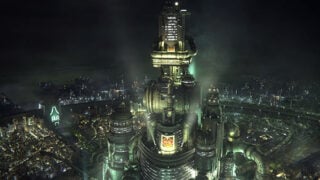Final Fantasy VII Remake producer Yoshinori Kitase and co-director Naoki Hamaguchi discuss rebuilding Midgar
Remake creators share comments via the game's opening movie.
PlayStation Blog has published a new interview with Final Fantasy VII Remake producer Yoshinori Kitase and co-director Naoki Hamaguchi, who discuss the design decisions made in rebuilding the city of Midgar as seen in the opening movie.
Here are the developers’ comments:
- Regarding the opening scene, which shows an area devoid of life surrounding the city, Kitase said, “We didn’t want to go over the top with it. But there is very much the nuance that [Midgar] is damaging the surrounding area.”
- Regarding whether the development team used Final Fantasy VII: Advent Children as reference material for rebuilding Midgar, Hamaguchi said, “We did refer to Advent Children and other previous series’ work when rebuild Midgar. But one of the main things we actually set out to redo was the scale of the city itself. The original wasn’t that realistic if you consider the size of the individual buildings and how big they were in comparison to the overall city. It was quite condensed; we really set out to make Midgar realistic. The size between the buildings, the density… that’s one of the big things we set out to change.”
- Regarding whether the development team has a fully-designed topographical map of Midgar, Hamaguchi said, “We haven’t done it all to the same quality or same level of detail as the actual areas you do get to visit in the game, but we have mapped out the entire city and what’s in each of those areas.”
- Regarding whether Midgar’s design is feasible in the real world, Hamaguchi said, “You know the structure of Midgar; you’ve the big central pillar, and each sector is supported by its own sub-pillar. We worked out the right size and construction, how big those pillars would need to be to physically support the weight of the plate on top of them. Also the honeycomb structure of the pillars and where the tunnels would have to go for it to still work as a physical structure. That has all been mapped out and we understand quite a lot of detail about the realities of how Midgar would be constructed as a city.”
- Regarding everyday life in Midgar, Kitase said, “We really wanted to show the everyday lives of Midgar’s citizens. [Partly] to show how they lived in this massive city powered by Mako energy, how and when they’d be using it, to tell that aspect of the story. The original version went straight into the bombing mission. We wanted that feeling that things were already underway, you were in the middle of the action. Yet if you immediately went from there into the panic caused by the bombing mission afterwards, you wouldn’t understand the impact it had on the inhabitants’ everyday lives before that event interrupted them. That’s why we started with this domestic kind of scene.”
- Regarding the ongoing construction of the city, Kitase said, “The idea is that the city is being built from the center outwards. You can also sense the different architectural styles as you go out from the central pillar, with high-rises on the city edge. We’ve put quite a bit of effort into making you feel like it is modernizing as the city builds outwards.”
- Regarding the playground, Hamaguchi says, “Within each sector you’ve got the difference between rich and poor. Each plate is its own city. There are some areas within those that are older, beaten up. The playground is used to show there are downturned areas that aren’t so well off in the city areas too.”
- Regarding the Mako reactor, Kitase said, “Up to [this point in the opener] we’ve seen the benefits of living with Mako. It supports people’s comfortable lifestyle in the city. But the depiction here of the Mako reactor turning on is that it’s not all sunshine and rainbows; there’s a darker side to Mako as well.”
- Regarding the appearance of Loveless Street, Midgar’s entertainment hub which is notably close in proximity to Reactor No. 1, Hamaguchi said, “The player gets to see how the [Reactor bombing] impacts the city. We want them to feel conflicted about the effects of their actions. That’s why we depicted this area in such detail.”
- Regarding Shinra Headquarters, Hamaguchi said, “We didn’t want to mess with the outer form of the building, because it could really affect people’s memories of what Midgar should look like. The inside though, like the floor structure, has seen major rearranging. It’s something we want players to discover when they’re inside.”
- Regarding Midgar itself, Hamaguchi said, “The core concept we worked on was that the player must be able to experience Midgar for themselves. Each individual location within has distinctive concepts and personalities. There’s a different style of gameplay experience waiting in each one of them.”
- Regarding the game’s lighting technology, Hamaguchi said, “We’ve used new tech to enhance the game’s lighting, to make the city of Midgar feel as real as possible. A network of over 100 synced PCs do copious physics simulations, calculations to work out the exact realistic reflection and how the lighting beams will bounce off any object in the game. Through doing that we managed to create amazing atmospheric lighting for the city.”
Final Fantasy VII Remake is due out for PlayStation 4 on April 10 worldwide. A demo is available now via the PlayStation Store.